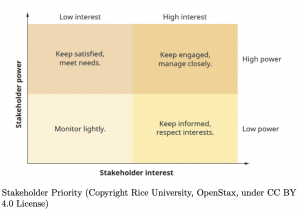Part 4: Duties and Stakeholder Theory
50 How can stakeholders be categorized?
Many theories for categorizing, managing, and prioritizing stakeholders exist. Some would advise to prioritize “internal” stakeholders (e.g., employees and shareholders) over “external” stakeholders (e.g., local communities, customers, and the environment). Others may divide stakeholders into different boxes, such as “functional” stakeholders (e.g., employees), “enabling” stakeholders (such as the government), and so on. For our purposes, one model of stakeholder categorization will be useful as we analyze issues. This “stakeholder priority” model divides stakeholders into “low interest” or “high interest” categories. High interest stakeholders closely monitor what a company does, often because the actions of the company deeply affect their lives. In contrast, “low interest” stakeholders are less concerned with the company’s actions and do not track its actions closely.
Then, stakeholders are further divided into “low power” and “high power” groups. Low power groups may not be able to affect the company, regardless of their interest in the company’s actions. High power stakeholders have an ability to deeply affect the company. For example, a company facing antitrust challenges would likely consider the government a “high power” stakeholder, due to the government’s ability to bring legal action to stop actions of the company or even break the company up. Once the company has categorized its stakeholders, one potential relationship with those stakeholders can be found on the Stakeholder Priority Figure below. For example, stakeholders who have high power and high interest (such as the federal government during an anti-trust issue) should be kept engaged and monitored closely, while low-interest, low-power stakeholders (such as former consumers for some companies) may be monitored lightly.


Exercises
- For the stakeholders you identified for the company you have been considering, categorize them as either low or high power and interest. Comment on what this implies for how the company should treat those stakeholders.

